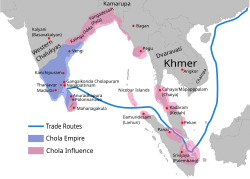This article needs additional citations for verification. (September 2023) |
Chola Empire | |
|---|---|
| 848–1279 | |
Gold Gadyana coin of emperor Rajaraja I (985–1014). Uncertain Tamil Nadu mint. Legend "Chola, conqueror of the Gangas" in Tamil, seated tiger with two fish.
| |
 Map showing the greatest extent of the Chola empire c. 1030 under Rajendra I: territories are shown in blue, subordinates and areas of influence are shown in pink. | |
| Capital | Pazhaiyaarai, Thanjavur, Gangaikonda Cholapuram |
| Official languages |
|
| Religion | Hinduism |
| Government | Monarchy |
| Emperor | |
• 848–871 | Vijayalaya Chola (first) |
• 1246-1279 | Rajendra III (last) |
| Historical era | Middle Ages |
• Established | 848 |
• Empire at its greatest extent | 1030 |
• Disestablished | 1279 |
The Chola Empire, which is often referred to as the Imperial Cholas,[1] was a medieval Indian, thalassocratic empire that was established by the Chola dynasty that rose to prominence during the middle of the ninth century and united southern India under their rule.
The power and the prestige the Cholas had among political powers in South, Southeast, and East Asia at its peak is evident in their expeditions to the Ganges, naval raids on cities of the Srivijaya Empire on the island of Sumatra, and their repeated embassies to China.[2] The Chola fleet represented the peak of ancient Indian maritime capacity. Around 1070, the Cholas began to lose almost all of their overseas territories but the later Cholas (1070–1279) continued to rule portions of southern India. The Chola empire went into decline at the beginning of the 13th century with the rise of the Pandyan dynasty, which ultimately caused the Chola's downfall.[3]
The Cholas established a centralized form of government and a disciplined bureaucracy. Their patronage of Tamil literature and their zeal for building temples resulted in some of the greatest works of Tamil literature and architecture.[4] The Chola kings were avid builders, and regarded temples in their kingdoms as both places of worship and of economic activity.[5][6] A prime example of Chola architecture is Brihadisvara temple at Thanjavur, a UNESCO World Heritage Site, which the Rajaraja commissioned in 1010. They were also well known for their patronage of art. The development of the sculpting technique used in Chola bronzes of Hindu deities that were built using a lost wax process, was pioneered in their time. The Chola tradition of art spread, and influenced the architecture and art of Southeast Asia.[7][8]
- ^ Kaimal, Padma (May 1992). "Art of the Imperial Cholas. By Vidya Dehejia. New York: Columbia University Press, 1990. xv, 148 pp. 36.00". The Journal of Asian Studies (book review). 51 (2): 414–416. doi:10.2307/2058068. ISSN 1752-0401. JSTOR 2058068. S2CID 163175500.
- ^ K. A. Nilakanta Sastri, A History of South India, p. 158
- ^ K. A. Nilakanta Sastri, A History of South India, p. 195–196
- ^ Keay 2011, p. 215.
- ^ Vasudevan, pp. 20–22
- ^ Keay 2011, pp. 217–218.
- ^ Promsak Jermsawatdi, Thai Art with Indian Influences, p. 57
- ^ John Stewart Bowman, Columbia Chronologies of Asian History and Culture, p. 335
© MMXXIII Rich X Search. We shall prevail. All rights reserved. Rich X Search

